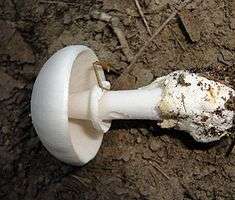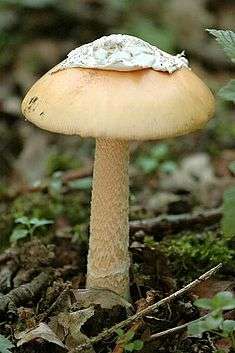Amanita magnivelaris
| Great Felt Skirt Destroying Angel | |
|---|---|
 | |
| Scientific classification | |
| Kingdom: | Fungi |
| Division: | Basidiomycota |
| Class: | Agaricomycetes |
| Subclass: | Hymenomycetes |
| Order: | Agaricales |
| Family: | Amanitaceae |
| Genus: | Amanita |
| Species: | A. magnivelaris |
| Binomial name | |
| Amanita magnivelaris Peck | |
| Amanita magnivelaris | |
|---|---|
|
| |
| gills on hymenium | |
|
cap is convex or flat | |
| hymenium is free | |
| stipe has a ring and volva | |
| spore print is white | |
| ecology is mycorrhizal | |
| edibility: deadly | |
Amanita magnivelaris, commonly known as the great felt skirt destroying angel, is a poisonous basidiomycete fungus, one of many in the genus Amanita. Originally described from Ithaca, New York, by Charles Horton Peck, it is found in New York state and southeastern Canada.[1]
See also
References
- ↑ Tulloss R. "Amanita magnivelaris". Amanita studies. Retrieved 2010-08-01.
This article is issued from Wikipedia - version of the 9/4/2016. The text is available under the Creative Commons Attribution/Share Alike but additional terms may apply for the media files.

